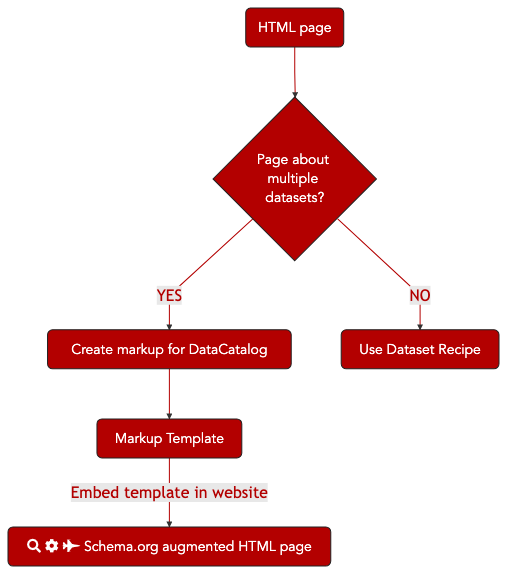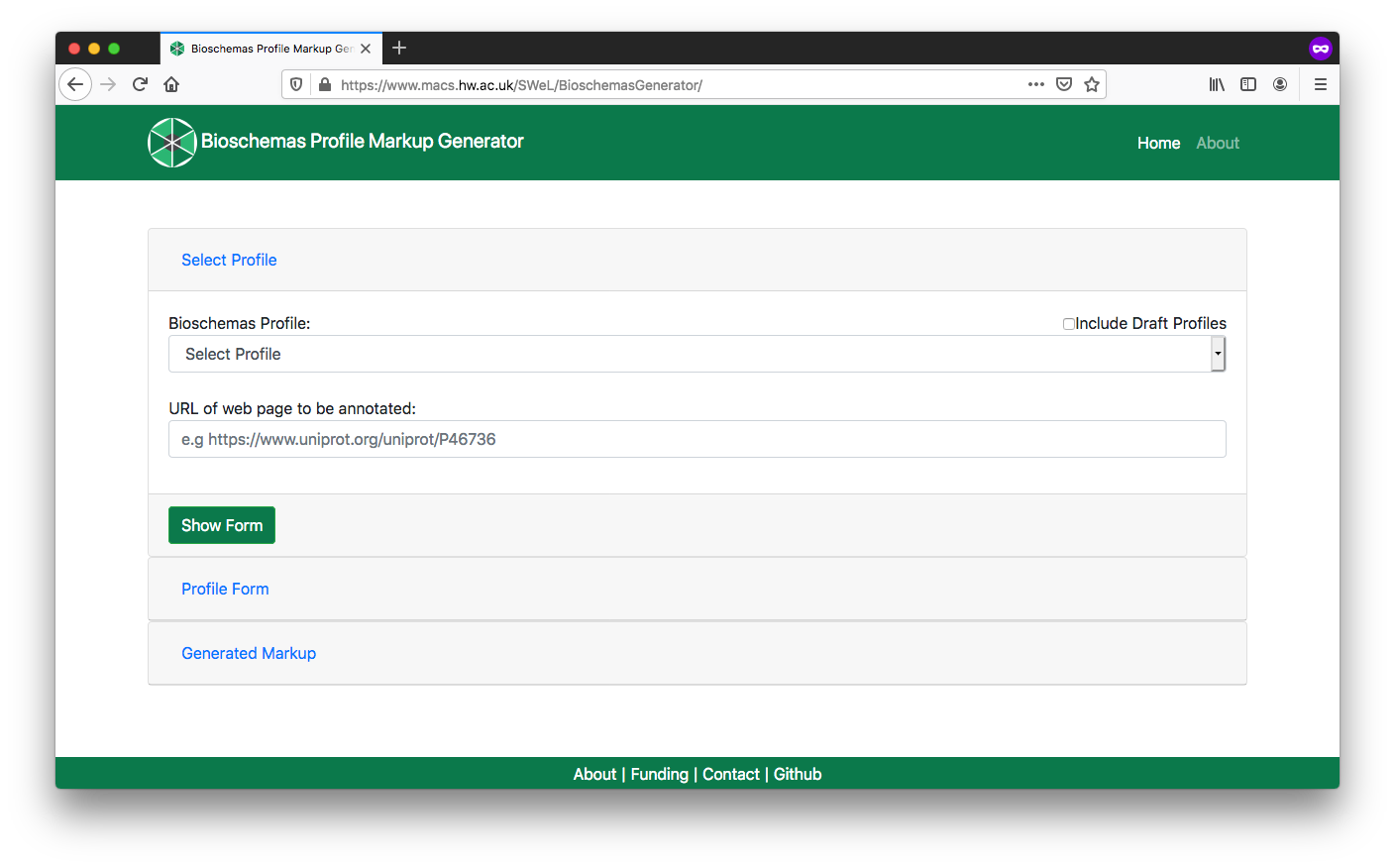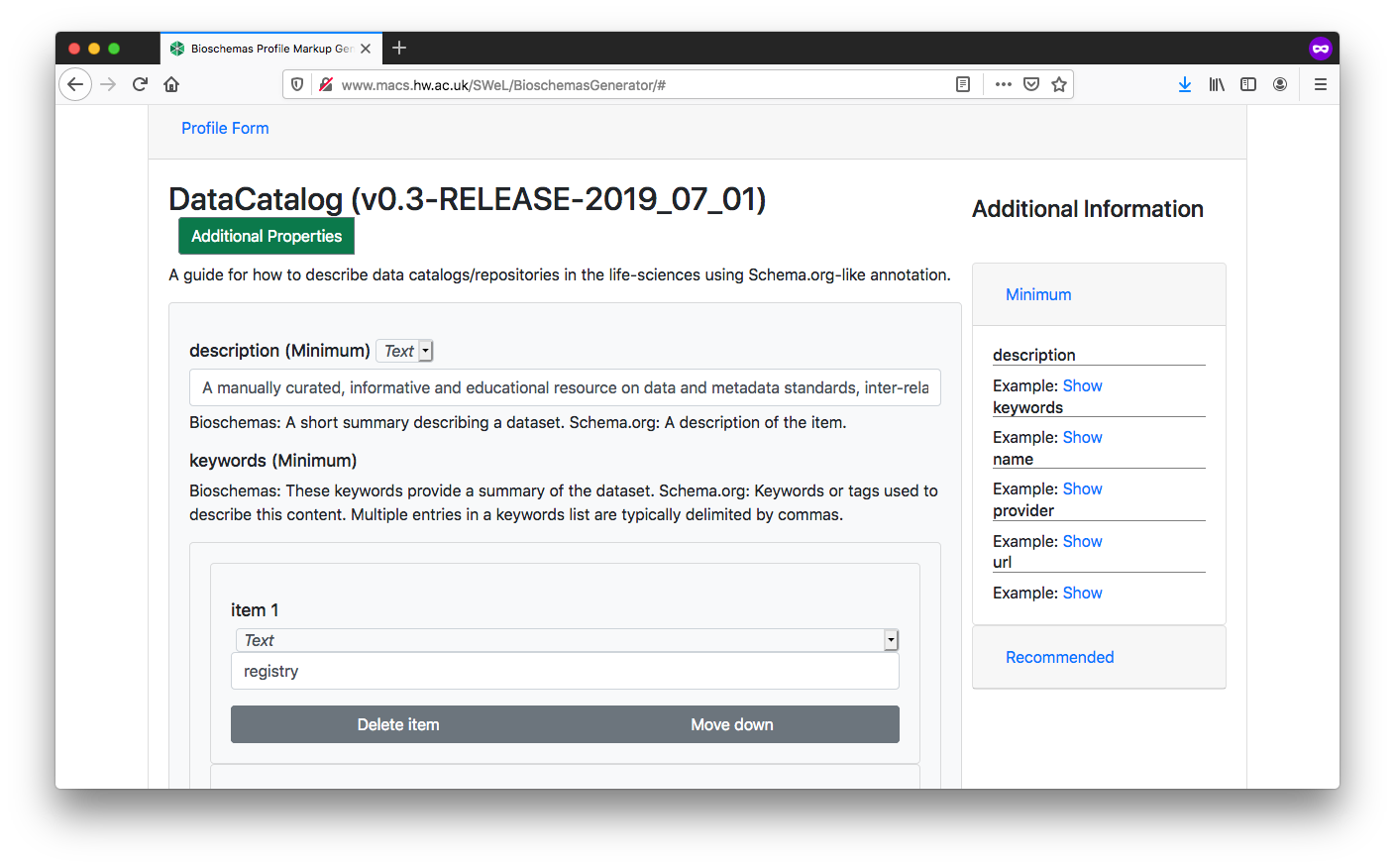9.9.3. Data catalogue markup¶
9.9.3.1. Main Objectives¶
The main purpose of this recipe is:
To embed
Schema.orgmarkup in a web page that publishes multiple datasets in a single page.
9.9.3.2. Graphical Overview¶

Fig. 9.9 The process of annotating a data catalog webpage with bioschema markup for Search Engine discovery.¶
9.9.3.3. Capability & Maturity Table¶
Capability |
Initial Maturity Level |
Final Maturity Level |
|---|---|---|
Findability |
minimal |
repeatable |
Interoperability |
minimal |
9.9.3.4. Method¶
We will outline the steps for marking up a page in your site that is about multiple datasets. The resulting markup will be compliant with both Google’s Dataset markup guidelines and the Bioschemas DataCatalog Profile.
We will use FAIRsharing as an example for this recipe which makes three datasets available within its markup.
Identify the page in your site about a specific dataset, e.g. https://fairsharing.org/
Open the Bioschemas Generator
Select
DataCatalogfrom the Bioschemas Profile dropdownEnter the URL of the page in URL box, e.g.
https://fairsharing.org/Click on the
Show Formbutton

Fig. 9.10 Bioschemas Generator start screen.¶
Complete the profile form with the information relevant for your page. Once completed, click on the
Generate MarkupbuttonYou should complete all Minimum properties and as many Recommended properties as possible. You can show/hide properties using the
Additional Propertiesbuttons.Where possible you should link to other resources. The Bioschemas Generator does not make this as simple as it could, but you can do it in step 5 once you have generated your markup, e.g. our dataset will link to a page with DataCatalog markup in rather than repeating all the properties for now we will just enter a
urland no other properties.If there are separate pages for your datasets then you should link to them using an
@idlinkOtherwise you can include the markup within the
DataCatalogmarkup
The form defaults to the data type with the first alphabetical character, e.g. for
identifierthis defaults toPropertyValuebutTextorURLwill be more appropriate in most casesThe right side of the screen gives examples for properties, where these have been provided by the Bioschemas profile authors. Click on the
Showbutton to see the example for a specific property. Click onMinimum,Recommended, orOptionalto expand/contract the section and see the properties contained at that marginality level

Fig. 9.11 Bioschemas Generator DataCatalog profile form.¶
You will now see the generated markup in
JSON-LDformat. You can click on theMicrodataandRDFatabs to see the same content rendered in the different formats. However, we recommend the use ofJSON-LD. For our FAIRsharing.org example, we get the following markup<script type="application/ld+json" > { "@context": "http://schema.org", "@id": "https://fairsharing.org/", "@type": "DataCatalog", "alternateName": [ "BioSharing.org" ], "citation": [ { "@id": "https://doi.org/10.1038/s41587-019-0080-8", "@type": "CreativeWork" } ], "dataset": [ { "@context": "http://schema.org", "@type": "Dataset", "dct:conformsTo": "https://bioschemas.org/profiles/Dataset/0.3-RELEASE-2019_06_14", "description": "A manually curated registry of standards, split into three types - Terminology Artifacts (ontologies, e.g. Gene Ontology), Models and Formats (conceptual schema, formats, data models, e.g. FASTA), and Reporting Guidelines (e.g. the ARRIVE guidelines for in vivo animal testing). These are linked to the databases that implement them and the funder and journal publisher data policies that recommend or endorse their use.", "identifier": [ "https://www.fairsharing.org/bsg-sXXXXXX" ], "keywords": [ "Standards", "Metadata", "Formats", "Ontologies", "Terminology Artifacts", "Reporting Guidelines" ], "name": "Metadata Standard", "url": "https://fairsharing.org/standards" }, { "@context": "http://schema.org", "@type": "Dataset", "dct:conformsTo": "https://bioschemas.org/profiles/Dataset/0.3-RELEASE-2019_06_14", "description": "A manually curated registry of databases/data repositories, conforming to the BioDBcore standard (from the Life Sciences). These are linked to the standards that they use and the funder and journal publisher data policies that recommend or endorse their use.", "identifier": [ "https://www.fairsharing.org/bsg-dXXXXXX" ], "keywords": [ "Database", "Data repository" ], "name": "Database", "url": "https://fairsharing.org/databases" }, { "@context": "http://schema.org", "@type": "Dataset", "dct:conformsTo": "https://bioschemas.org/profiles/Dataset/0.3-RELEASE-2019_06_14", "description": "A manually curated registry of data policies from research funders, journal publishers, societies, and other organisations. These are linked to the databases and standards that they recommend for use", "identifier": [ "https://www.fairsharing.org/bsg-pXXXXXX" ], "keywords": [ "Data policy", "journal", "funder", "society" ], "name": "Data Policy", "url": "https://fairsharing.org/policies" } ], "dct:conformsTo": "https://bioschemas.org/profiles/DataCatalog/0.3-RELEASE-2019_07_01", "description": "A manually curated, informative and educational resource on data and metadata standards, inter-related to databases/data repositories and funder and journal publisher data policies from across disciplines. FAIRsharing is an ELIXIR-UK node resource and has an active role in the RDA and Force11 data initiatives.", "identifier": [ "https://identifiers.org/MIR:00000364" ], "keywords": [ "registry", "life science", "natural science", "social science" ], "license": { "@id": "https://creativecommons.org/licenses/by-sa/4.0/", "@type": "CreativeWork" }, "name": "FAIRsharing.org", "provider": [ { "@context": "http://schema.org", "@type": "Organization", "dct:conformsTo": "https://bioschemas.org/profiles/Organization/0.2-DRAFT-2019_07_19", "description": "", "name": "FAIRsharing.org Registry" } ], "url": "https://fairsharing.org/" } </script >
Download or copy and paste the generated markup
Make adjustments for any bits that could not be properly entered through the form.
For example, for our generated markup we would change the
providerso that it provides a direct link rather than repeating the properties. We would replace"provider": [ { "@context": "http://schema.org", "@type": "Organization", "dct:conformsTo": "https://bioschemas.org/profiles/Organization/0.2-DRAFT-2019_07_19", "description": "", "name": "FAIRsharing.org Registry" } ],
with
"provider": [ { "@type": "Organization", "@id": "https://fairsharing.org/communities" } ],
You can test that your JSON-LD is valid syntax, and visualise your markup using the JSON-LD Playground.
Once you are happy with your markup, include the
JSON-LD, script tags and all, at the bottom of your HTML page template. Make sure that this is before the closing</html>tag
Your site should now include DataCatalog markup.
Once you have deployed this on your web server, you can test it with the Bioschemas Validator which scrapes the markup from your page and allows you to test it against various Bioschemas profiles1.
9.9.3.5. FAIRification Objectives, Inputs and Outputs¶
Actions.Objectives.Tasks |
Input |
Output |
|---|---|---|
9.9.3.6. Table of Data Standards¶
Data Formats |
Terminologies |
Models |
|---|---|---|
9.9.3.7. References¶
References
1: The Bioschemas Validator is currently in an early alpha release and does not include all the profiles
9.9.3.8. Authors¶
Authors
Name |
ORCID |
Affiliation |
Type |
ELIXIR Node |
Contribution |
|---|---|---|---|---|---|
Heriot Watt University |
Writing - Original Draft |
||||
ZB MED Information Centre for life sciences |
Writing - Review & Editing |
||||
University of Oxford |
Writing - Review & Editing |


